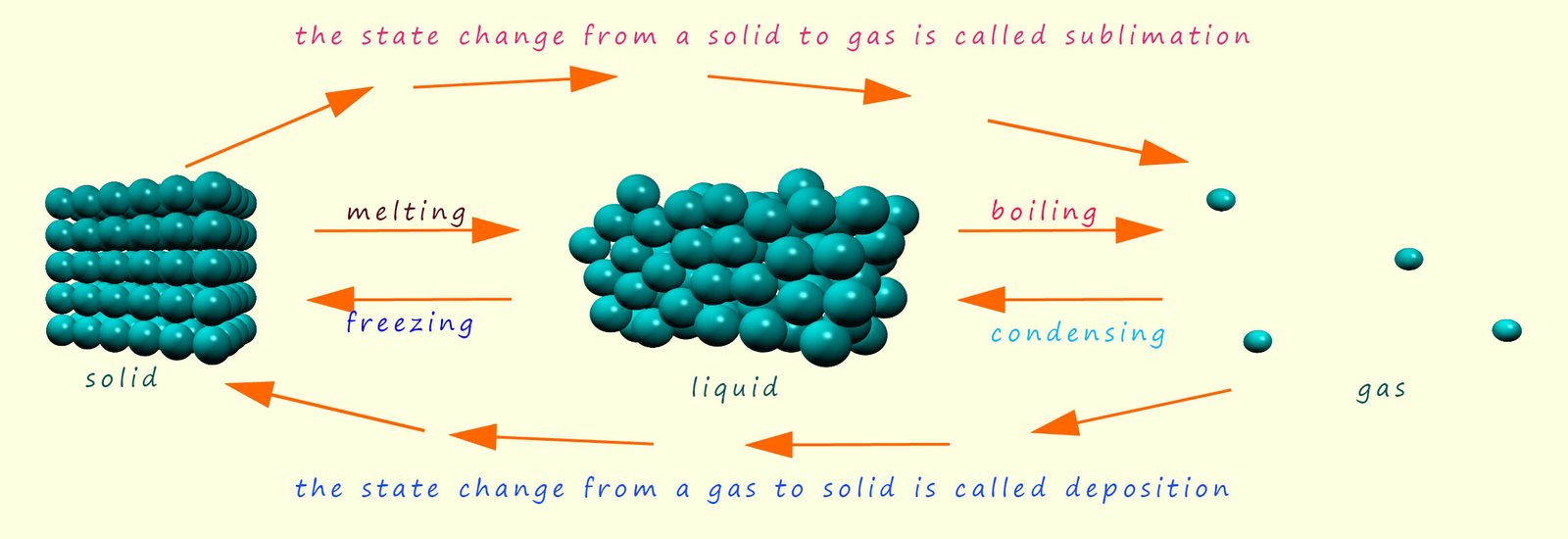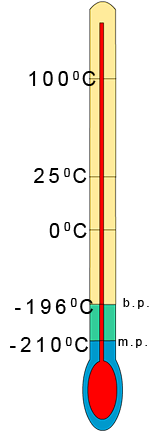Higher and foundation tiers
The three states of matter
The particle model as its name suggests is a model or theory used by scientists to explain many of the
physical properties
of matter (solids, liquid and gases). The
particle theory or model assumes that all matter is made up of
particles. These particles:
- Are constantly moving in a random way.
- All the particles in solids,
liquids and gases have energy. The particles in solids have
the least energy and the particles in a
gas have
the most energy.
- If the particles gain or lose enough energy
they can change from one state to another.
- When collisions happen between the particles there is no loss of
kinetic energy - that is the collisions are
elastic.
- Are assumed as being solid spheres with no forces between them.
The particle model is used to describe how the particles in solids, liquids and gases are arranged. I am sure you will have
seen these particle pictures of the three states of matter from previous science lessons.
The particle pictures are shown below:
Solids
 In a solid:
In a solid:
- The particles are close together in fixed positions. They vibrate about these fixed positions.
- There are strong forces of attraction between the particles in a
solid which keeps them in place and prevents them from moving but they can vibrate about their fixed position.
- Since the particles cannot move freely from one point to another. Solids have a fixed shape and a fixed volume.
- Solids cannot be compressed. The
particles are already touching and so cannot be forced closer together.
Liquids
 In a liquid:
In a liquid:
- The particles are in constant random motion.
- the particles are touching, this means like
solids they cannot be compressed. The
particles in a liquid cannot be forced
any closer together.
- The particles can slide and flow over each other so
liquids they have no fixed shape, they take the shape of their container.
They may take the shape of their container but liquid have a
fixed volume.
Gases
 In a gas the particles:
In a gas the particles:
- Move very fast in all directions in a totally random way.
- Spread out quickly to fill any container they are in. They have
no fixed shape but take the shape of the container
they are in
- Have weak forces of attraction between them.
- Have large gaps between them so gases are mostly empty space so
they are easily compressed.
Changing state
During a chemical change (a chemical reaction) new substances are made; the
reactants turn into products. During a
physical change no new substances are made. The
particles simply rearrange themselves by losing or gaining energy e.g.
melting, freezing and boiling are all physical changes.
To change the state of a substance from a solid to liquid
to gas, at each of these steps the particles
need to gain kinetic energy;
that is they need to move faster. The particles will also start to
separate and move apart as they gain kinetic energy (move faster).
You need to think about what type of structure the substance being heated has. Does it have a small molecular structure with weak intermolecular bonds or does it have a giant structure, either ionic or a giant covalent structure? Remember
that intermolecular bonds are around 3-10% the strength of a typical covalent bond so will require considerably less
energy to break.
The stronger the forces of attraction between the
particles the more heat energy will have to be
provided in order to overcome and break the bonds/intermolecular forces
holding the particles together. If the
substance being heated has a giant structure with lots of strong ionic
or covalent bonds then lots of energy will
have to be supplied to break these bonds and the substance
will have a very high melting and boiling point.
The diagram below gives the names of each of the state changes that take place when one state of matter changes to another.

Predicting states
 To predict the state of a substance at a certain temperature
is not always as straight forward as it seems; especially
when the melting and boiling points are very low e.g. nitrogen gas has a melting point of -2100C and a
boiling point
of -1960C . To help you predict the state of a substance at a given
temperature quickly sketch out a small thermometer at the side of your page (as shown opposite).
Mark on it
room temperature, 250C . Also as a guide mark
on 00C and 1000C ; the melting and
boiling points
of water. Do not try
and mark your scale accurately just space the numbers out approximately.
Next mark on your thermometer the melting and
boiling points of the substance you have been given; in this case the m.p.
is -2100C and the b.p. is -1960C . Just mark these numbers roughly where they might come on the scale
don't try to be
accurate it's not necessary. Mark or colour above and below these numbers as shown in the diagram opposite.
To predict the state of a substance at a certain temperature
is not always as straight forward as it seems; especially
when the melting and boiling points are very low e.g. nitrogen gas has a melting point of -2100C and a
boiling point
of -1960C . To help you predict the state of a substance at a given
temperature quickly sketch out a small thermometer at the side of your page (as shown opposite).
Mark on it
room temperature, 250C . Also as a guide mark
on 00C and 1000C ; the melting and
boiling points
of water. Do not try
and mark your scale accurately just space the numbers out approximately.
Next mark on your thermometer the melting and
boiling points of the substance you have been given; in this case the m.p.
is -2100C and the b.p. is -1960C . Just mark these numbers roughly where they might come on the scale
don't try to be
accurate it's not necessary. Mark or colour above and below these numbers as shown in the diagram opposite.

- The blue section; below its melting point at -2100C
means that the substance has not yet melted
so it's a solid here.
- The greenish section is below the
boiling point (b.p.) so it has not yet boiled; the substance
is still a liquid.
- The yellow portion is above the boiling point so the substance; nitrogen in this case is a gas.
Drawing these thermometer diagrams as a quick sketch only takes a few seconds and helps avoid you getting the wrong answer when asked to predict the state of a substance at a given temperature.
Limitations of the particle model
Like most scientific model the particle model is not perfect; it has its good and bad points.
However some of the assumptions that it makes are not always valid:
- One of the assumptions of the particle model is that it assumes that all the
particles
are solid spheres with no forces between them. In reality the
particles are likely to be ions or
molecules which will have attractive forces between them.
The particles could be molecules with fairly large
intermolecular
bonding/forces of attraction between them. These intermolecular forces can have large effects on properties such as viscosity
and melting and boiling points. If the particles are charged; such as ions then the forces between them will be large.
- The particle theory suggests that the collisions between
particles will be elastic; that is collisions with no loss of kinetic energy; however it
is highly likely that kinetic energy is not conserved and the collisions are in fact inelastic.
Practice questions
Next


 In a solid:
In a solid:
 In a liquid:
In a liquid:
 In a gas the particles:
In a gas the particles:

 To predict the state of a substance at a certain temperature
is not always as straight forward as it seems; especially
when the melting and boiling points are very low e.g. nitrogen gas has a melting point of -2100C and a
boiling point
of -1960C . To help you predict the state of a substance at a given
temperature quickly sketch out a small thermometer at the side of your page (as shown opposite).
Mark on it
room temperature, 250C . Also as a guide mark
on 00C and 1000C ; the melting and
boiling points
of water. Do not try
and mark your scale accurately just space the numbers out approximately.
Next mark on your thermometer the melting and
boiling points of the substance you have been given; in this case the m.p.
is -2100C and the b.p. is -1960C . Just mark these numbers roughly where they might come on the scale
don't try to be
accurate it's not necessary. Mark or colour above and below these numbers as shown in the diagram opposite.
To predict the state of a substance at a certain temperature
is not always as straight forward as it seems; especially
when the melting and boiling points are very low e.g. nitrogen gas has a melting point of -2100C and a
boiling point
of -1960C . To help you predict the state of a substance at a given
temperature quickly sketch out a small thermometer at the side of your page (as shown opposite).
Mark on it
room temperature, 250C . Also as a guide mark
on 00C and 1000C ; the melting and
boiling points
of water. Do not try
and mark your scale accurately just space the numbers out approximately.
Next mark on your thermometer the melting and
boiling points of the substance you have been given; in this case the m.p.
is -2100C and the b.p. is -1960C . Just mark these numbers roughly where they might come on the scale
don't try to be
accurate it's not necessary. Mark or colour above and below these numbers as shown in the diagram opposite.
